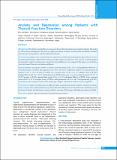Please use this identifier to cite or link to this item:
https://hdl.handle.net/20.500.14356/1263Full metadata record
| DC Field | Value | Language |
|---|---|---|
| dc.contributor.author | Gorkhali, Binu | - |
| dc.contributor.author | Sharma, Sita | - |
| dc.contributor.author | Amatya, Mrigendra | - |
| dc.contributor.author | Acharya, Devaka | - |
| dc.contributor.author | Sharma, Muna | - |
| dc.date.accessioned | 2023-05-04T06:27:10Z | - |
| dc.date.available | 2023-05-04T06:27:10Z | - |
| dc.date.issued | 2020 | - |
| dc.identifier.citation | GorkhaliB., SharmaS., AmatyaM., AcharyaD., & SharmaM. (2020). Anxiety and Depression among Patients with Thyroid Function Disorders. Journal of Nepal Health Research Council, 18(3), 373-378. https://doi.org/10.33314/jnhrc.v18i3.2499 | en_US |
| dc.identifier.issn | Print ISSN: 1727-5482; Online ISSN: 1999-6217 | - |
| dc.identifier.uri | http://103.69.126.140:8080/handle/20.500.14356/1263 | - |
| dc.description | Original Article | en_US |
| dc.description.abstract | Abstract Background: Psychiatric comorbidities are common in thyroid disorder patients and complicate patients’ life quality as well as disease management. We aimed to explore prevalence of anxiety and depression and identify associated characteristics among patients with thyroid function disorder. Methods: A descriptive, cross-sectional study was conducted on 129 thyroid disorder patients aged ?20 years. A semi-structured questionnaire, Beck Anxiety Inventory, and Beck Depression Inventory were used for sociodemographic characteristics, anxiety, and depression respectively. Group differences were compared (Chi square) or correlations were determined (Pearson’s correlation coefficient). Results: Patients’ mean age was 38.09±12.68 years; most were females (102, 79.1%) and hypothyroid (90, 69.8%). Overall prevalence of anxiety and depression were 50.4% and 42.6% respectively. Anxiety was more prevalent in females (54.9% vs 33.3% in males, p=0.046), low economic status (73.9% vs 35.5% in higher status, p=0.019), and hyperthyroid (64.1% vs 44.4% in hypothyroid, p=0.040). Depression was more prevalent in females (47.1% vs 25.9% in males, p=0.048), Janajati ethnic group (54.8% vs 31.1% in Brahmin-Chhetri, p=0.002), lower economic status (69.6% vs 35.5% in higher status, p=0.016), and hyperthyroid (56.4% vs 36.7% in hypothyroid, p=0.037). Associations with occupation, marital status, family type, religion, and duration of illness were not significant. Conclusions: Anxiety and depression are highly prevalent among thyroid disorder patients, especially in females, lower economic status, and hyperfunction type thyroid disorder. Management of thyroid disorders should incorporate treatment of anxiety and depression; routine psychiatric screening of the groups with higher prevalence is advisable. Keywords: Anxiety; depression; prevalence; thyroid function disorders | en_US |
| dc.language.iso | en | en_US |
| dc.publisher | Nepal Health Research Council | en_US |
| dc.relation.ispartofseries | Jul-Sep 2020; | - |
| dc.subject | Anxiety | en_US |
| dc.subject | Depression | en_US |
| dc.subject | Prevalence | en_US |
| dc.subject | Thyroid function disorders | en_US |
| dc.title | Anxiety and Depression among Patients with Thyroid Function Disorders | en_US |
| dc.type | Journal Article | en_US |
| local.journal.category | Original Article | - |
| Appears in Collections: | Vol. 18 No. 3 (2020): Vol. 18 No. 3 Issue 48 Jul-Sep 2020 | |
Files in This Item:
| File | Description | Size | Format | |
|---|---|---|---|---|
| 2499-Manuscript-18827-1-10-20201115.pdf | Fulltext Article. | 174.55 kB | Adobe PDF |  View/Open |
Items in DSpace are protected by copyright, with all rights reserved, unless otherwise indicated.
